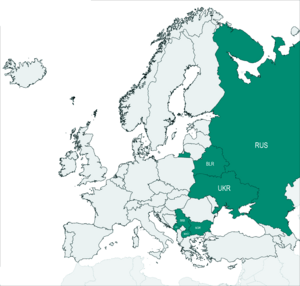Eastern Orthodox Slavs facts for kids

Eastern Orthodox Slavic countries
|
|
| Total population | |
|---|---|
| 215,789,388 (2015) | |
| Regions with significant populations | |
| Eastern and Southeastern Europe | |
| Languages | |
| East Slavic South Slavic |
|
| Religion | |
| Eastern Orthodox Church | |
| Related ethnic groups | |
| Other Slavs |
The Eastern Orthodox Slavs form a religious grouping of the Slavic peoples, including ethnic groups and nations that predominantly (or have historically) adhere to the Eastern Orthodox Christian faith and whose Churches follow the Byzantine Rite liturgy. Eastern Orthodoxy spread to Eastern Europe in the Early Middle Ages through Byzantine influence, and has been retained in several countries until today.
Eastern Orthodox Slavic nations today include the Belarusians, Bulgarians, Macedonians, Montenegrins, Russians, Serbs and Ukrainians. They inhabit three separate contiguous areas in Eastern Europe (see map), namely a big one including most of the Russian Federation plus Ukraine and Belarus, a small one in the west, the Kaliningrad oblast which is an exclave of the Russian Federation, and a medium-sized one in the south including Bulgaria and several (but not all) countries of former Yugoslavia. They stretch from the northeast in the Baltic Sea to the Carpathian and Balkan Mountains in the southeast and southwest; from the north in the Russian Federation to the southwest in North Macedonia near the Greek border. There are also major Eastern Orthodox Slavic population hubs and communities in North Asia (predominantly Siberia), the Americas (predominantly North America), and significant diaspora groups throughout the rest of the world.
All Eastern Orthodox Christian Churches with Slavic-language liturgy, with the exception of the Bulgarian Church, use the Julian calendar ("Old Style") exclusively, and all use it to calculate the date Easter is celebrated.
States
Slavic states with Eastern Orthodox majority or plurality:
| State | Adherents |
|---|---|
| 84.59% (2011 census) | |
| 77% (2019 research) | |
| 71% (2016 research) | |
| 72.07% (2011 census) | |
| 69.6% (2011 census) | |
| 67.3% (2016 research) | |
| 48.3% (2011 census) |
Other Slavic-majority states with notable Eastern Orthodox minorities include Bosnia and Herzegovina (30.75%, 2013 census) and Croatia (4.44%, 2011 census). Small numbers are found in West Slavic countries such as Slovakia (0.9%, 2011), Poland (0.7%, 2011), and the Czech Republic. There are notable Eastern Orthodox Slavic communities among non-Slavic majority states.
Autocephalous churches
| Church | Year autocephaly granted | Number of followers |
|---|---|---|
| Russian Orthodox Church | 1589 | 110 million |
| Orthodox Church of Ukraine | 2019 | 20 million |
| Serbian Orthodox Church | 1219 | 8 – 12 million |
| Bulgarian Orthodox Church | 870 | 8–10 million |
| Polish Orthodox Church | 1924 | 504,000 |
| Czech and Slovak Orthodox Church | 1998 | 100,000 |
Historically, Bulgaria became the earliest and most important centre of the Slavic Eastern Orthodoxy, when its early Christianization in 864 allowed it to develop into the cultural and literary center of Slavic Europe, as well as one of the largest states in Europe, during the period considered as the Golden Age of medieval Bulgarian culture. The autocephaly of the Bulgarian national church was recognized in 870, the first among the Slavs. A major event was the development of the Cyrillic script at the Preslav Literary School, declared official in 893, as was the liturgy in Old Church Slavonic, also called Old Bulgarian.
In 918/919 the Bulgarian Patriarchate became the first Slavic autocephalous Patriarchate, fifth in the Eastern Orthodox Church after the Four Ancient Patriarchates of Constantinople, Alexandria, Antioch and Jerusalem. This status was officially recognized by the Patriarchate of Constantinople in 927.

